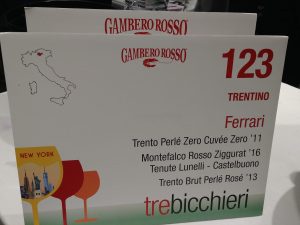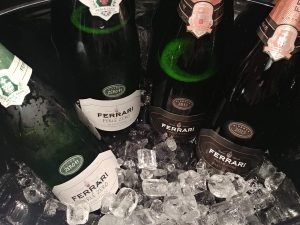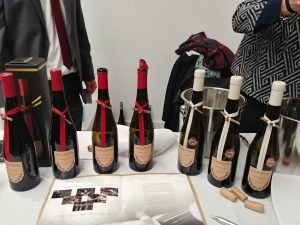
Gambero Rosso showcased the winners of its famed annual Tre Bicchieri wine award on March 1, 2019 at the Metropolitan Pavilion in New York City and, as usual, there were absolutely no disappointments. Winning wineries from virtually all of Italy’s most notable wine making regions were in attendance along with media and trade, glass in hand, ready to taste this year’s best vintages. Italy is arguably the most diverse winemaking region in the world and everything from sparkling and whites to rose’s and reds were poured. It would be almost impossible to cover every one, two and three Tre Bicchieri award winning wine offered that day so here are a few highlights.
When it comes to sparkling wine, champagne indisputably holds the greatest prestige. The highly specialized process of producing champagne which is restricted to the use of three varietals –Chardonnay, Pinot Noir and Pinot Meunier that undergo a secondary fermentation in the bottle, a process known as methode champenoise that gives champagne its fine and persistent mousse — is often recognized as being a solely French sparkling winemaking method.
Prosecco, an Italian sparkling wine that is crafted using the charmat method where carbon is introduced during the fermentation process in stainless steel vats, is arguably the most well known Italian bubbly. However Italian sparkling wines go beyond Prosecco. While there are many fine Prosecco D.O.C.G.s out there, Italy also produces sparkling wines using the methode champenoise or metodo classico. One of these is known as Franciacorta. Franciacorta comes from Lombardy, an area within the Northern Italian province of Brescia. Another is Trentodoc Italian sparkling wines from the mountainous Trentino Alto Adige region also in Northern Italy. Production in both these regions is small and highly specialized. There are a number of correlations between Franciacorta and Trentodoc, and Champagne as it relates to their production processes. Like champagne, Franciacorta is made using three principal grapes. Chardonnay comprises eighty percent while Pinot Bianco and Pinot Nero make up twenty percent of production. Trentodoc allows four varietals with Chardonnay and Pinot Noir making up the majority and Pinot Bianco and Pinot Meunier the remainder.
Tre Bicchieri award winner and soon-to-be organic Berlucchi Vineyards created its first Franciacorta in 1961 as a result of a collaboration between Guido Berlucchi and winemaker Franco Ziliani who decided a few years earlier to employ the metodo classico in his sparkling wine production, and the aptly named Belucchi 61 line were standouts among stiff competition.

The 61 Nature Vintage comprised of seventy percent Chardonnay and thirty percent Pinot Nero with zero dosage was characterized by fresh citrus and orchard fruit notes, as well as delicate bubbles.

The Berlucchi 61 Rose’ consisting of forty percent Chardonnay and sixty percent Pinot Nero with a dosage of six and a half percent was distinguished by raspberry and strawberry fruit notes, acidity, and a persistent effervescence.

The 61 Saten consisting of one hundred percent Chardonnay with six and a half percent dosage exhibited balanced citrus, vanilla and subtle almond notes, soft acidity, and fine bubbles.
This year’s Tre Bicchieri sparkling wine of the year award went to Ferrari vineyards from the Trentodoc. Guido Ferrari is credited with having created the first sparkling wine in this region in 1902 and Ferrari Vineyards was instrumental in bringing the D.O.C.G. designation to Trentino Alto Adige.

The Ferrari Extra Brut (meaning its dosage or sugar content is between zero and six grams per liter) was crisp, with bright lemon and green apple notes, and a refreshing acidity.

The Ferrari Perle Rose’ was soft and supple, with fresh raspberry and peach notes, along with persistent effervescence.
The region of Friuli is known for producing some of the finest Pinot Grigio in Italy. The high altitude, moderate climate and mineral rich soil combine to make this area prime winemaking territory.

Italo Cescon Vineyards showcased a soft and supple Italo Cescon Pinot Grigio with ripe peach and orchard fruit notes, soft acidity and a delicate finish.
The vineyard also makes a lovely Pinot Noir that exhibited lush cherry, raspberry and slightly earthy notes, as well as juicy acidity and a well rounded finish.
The highlight of Italo Cescon’s award winning portfolio was the organically produced and unfiltered Italo Cescon Madre. The wine, named for the vineyard’s matriarch, consists of one hundred percent Manzoni Bianco and is characterized by fresh orchard fruit, lime and herbaceous notes, and a balanced mineral driven finish. It is one of many examples of the exemplary nature and the unique character that distinguish the Tre Bicchieri award winners in a country that has become synonymous with fine winemaking.

Be First to Comment